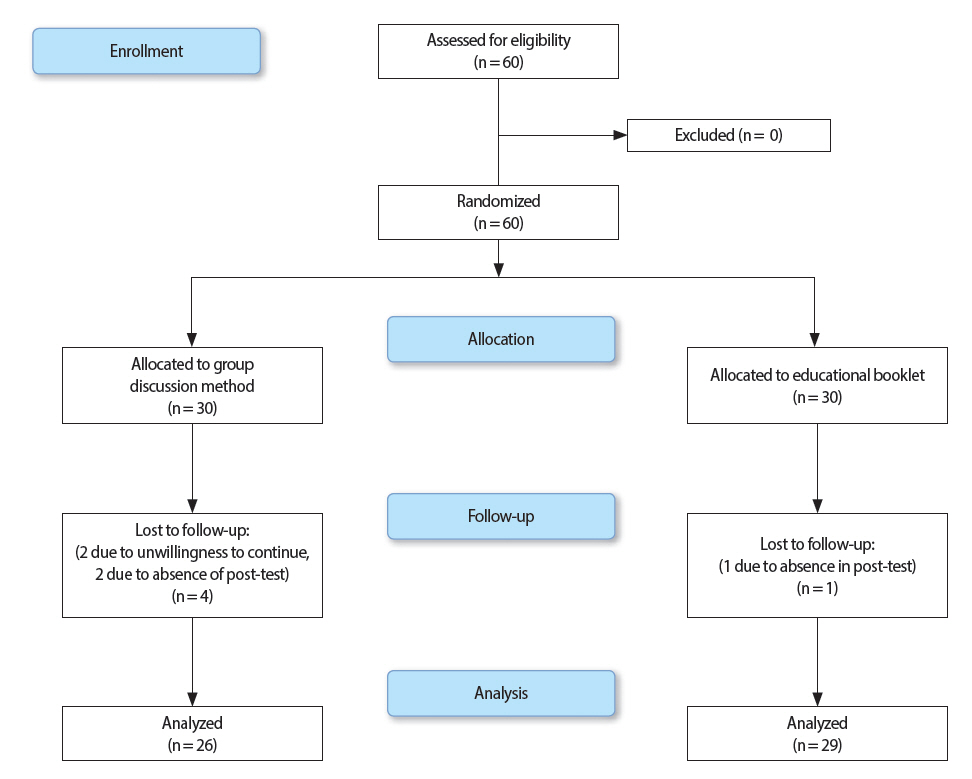J Educ Eval Health Prof.
2016;13:29. 10.3352/jeehp.2016.13.29.
Comparison of effect between group discussion and educational booklet on Iranian nursing students' attitude and practice toward patient privacy
- Affiliations
-
- 1Medical Surgical Nursing Department, Faculty of Nursing and Midwifery, Kashan University of Medical Sciences, Kashan, Iran. adibhajbagheri_m@kaums.ac.ir
- KMID: 2413778
- DOI: http://doi.org/10.3352/jeehp.2016.13.29
Abstract
- PURPOSE
This study aimed to compare the effects between group discussion and educational booklet on nursing students' attitude and practice toward patient privacy in Iran.
METHODS
A two-group, pre-test and post-test design study was conducted in 2015. The study was conducted on 60 nursing students in Kashan, Iran who were randomly allocated into two groups to be trained on patient privacy either through group discussion or by an educational booklet. The students' attitude and practice were assessed before and after the education using a questionnaire and a checklist. Data analysis was performed through paired t-test, Wilcoxon signed ranks test, and independent samples t-tests.
RESULTS
Before the intervention, no significant differences were found between the group designated to group discussion and those designated to the educational booklet in the mean overall score of attitude (P=0.303) and practice (P=0.493) toward patient privacy. After the intervention, the mean attitude score significantly increased in the two groups (P=0.001). Moreover, the students' practice score was increased in the discussion group while it did not significantly change in the booklet group (P=0.001).
CONCLUSION
Both methods were effective on the students' attitude; however, the educational booklet did not affect their practice toward patient privacy. Group discussion can effectively improve the students' attitude and practice toward patient privacy.
Keyword
MeSH Terms
Figure
Reference
-
References
1. Baillie L. Patient dignity in an acute hospital setting: a case study. Int J Nurs Stud. 2009; 46:23–36. http://dx.doi.org/10.1016/j.ijnurstu.2008.08.003.
Article2. Adib-Hajbagheri M, Zehtabchi S. Evaluation of elderly patients’ privacy and their satisfaction level of privacy in selected hospitals in Esfahan. J Med Ethics Hist Med. 2014; 8:120–197.3. Nayeri ND, Aghajani M. Patients’ privacy and satisfaction in the emergency department: a descriptive analytical study. Nurs Ethics. 2010; 17:167–177. http://dx.doi.org/10.1177/0969733009355377.
Article4. Karimi R, Dehghan Nayeri N, Daneshvar Ameri Z, Mehran A, Sadeghi T. Nurses and inpatient adolescents’ perceptions on observance of privacy and its importance. Hayat. 2009; 15:21–30.5. Ghahramanian A, Rahmani A, Zamanzadeh V, Mohajel Aghdam A. Patients and nurses’ perspectives on respecting patients’ privacy during nursing care. Iran J Nurs. 2008; 21:37–45.6. Erdil F, Korkmaz F. Ethical problems observed by student nurses. Nurs Ethics. 2009; 16:589–598. http://dx.doi.org/10.1177/0969733009106651.
Article7. Dehghani-Mobarakeh M, Maghsoudi A, Malekpour-Tehrani A, Rahimi-Madiseh M. The viewpoints of members of medical teams about patients’ privacy. J Clin Nurs Midwifery. 2013; 2:9–17.8. Ebrahimi H, Jafar-Abadi MA, Arashtanab HN, Qasemiyan Khojaste Z. The effect of group-discussion on the nurses’ performance in recognizing patients’ rights. Med Sci Discov. 2016; 3:35–39.9. Derebery J, Giang GM, Gatchel RJ, Erickson K, Fogarty TW. Efficacy of a patient-educational booklet for neck-pain patients with workers’ compensation: a randomized controlled trial. Spine (Phila Pa 1976). 2009; 34:206–213. http://dx.doi.org/10.1097/BRS.0b013e318193c9eb.10. Mohamadirizi S, Fahami F, Bahadoran P. Comparison of the effect of multimedia and illustrated booklet educational methods on women’s knowledge of prenatal care. Iran J Nurs Midwifery Res. 2014; 19:127–131.11. Yaghobian M, Yaghobi T, Salmeh F, Golmohammadi F, Safari H, Savasari R, Ghanei N, Habibi K. Comparing the effect of teaching using educational booklets and lecture along with educational booklets on nurses’ knowledge about professional laws and regulations. Iran J Med Educ. 2010; 9:372–380.12. Salehi T, Eyni E, Sadeghe T. Effect of nursing staff regarding the privacy of information on patients in the emergency department. Iran J Nurs Res. 2015; 10:66–75.13. Siddharthan T, Nassali F, Kalyesubula R, Coca S, Rastegar A, Rabin T, Knauf F. An educational booklet for patient-centred health education about a non-communicable disease in low-income and middle-income countries. Lancet Glob Health. 2016; 4:S25. http://dx.doi.org/10.1016/S2214-109X(16)30030-4.
Article14. Ahmad ER, Khamis M, Younis EM, Alrady SA. Effect of a developed educational booklet about standard infection control precautions on nurses’ knowledge and practices at woman’s health center-assiut university hospital, Egypt. Med J Cairo Univ. 2012; 80:435–445.15. Rahman F, Khalil JK, Jumani NB, Ajmal M, Malik S, Sharif M. Impact of discussion method on students performance. Int J Bus Soc Sci. 2011; 2:84–94.16. Vaskooei Eshkevari K, Karimi M, Asnaashari H, Kohan N. The assessment of observing patients’ right in Tehran University of Medical Sciences’ hospitals. Iran J Med Ethics Hist Med. 2009; 2:47–54.17. Ghahramanian A, Rahmani A, Zamanzadeh V, Mohajel Aghdam A. Respecting patients privacy during nursing care in the viewpoint of Patients and nurses. Iran J Nurs. 2008; 21:37–45.18. Olsen JC, Cutcliffe B, O’Brien BC. Emergency department design and patient perceptions of privacy and confidentiality. J Emerg Med. 2008; 35:317–320. http://dx.doi.org/10.1016/j.jemermed.2007.10.029.
Article
- Full Text Links
- Actions
-
Cited
- CITED
-
- Close
- Share
- Similar articles
-
- Development Effect analysis of Web-based CIA program for Nursing: Application to Maternity Nursing
- Factors Influencing Patient Privacy Protection Behavior among Nursing Students
- The Effects of Hospice Unit Practice Education on Spiritual Well-being, Attitude to Death, and Hospice Awareness of Nursing Students
- Knowledge, Attitude, and Confidence on Patient Safety of Undergraduate Nursing Students
- The Effects of Learning Styles and Nursing Professional Attitude on Problem-Solving Ability among Nursing Students


